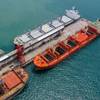Tariffs Hiked at Rotterdam Port
The tariffs which visiting sea-going vessels pay in Rotterdam will increase by 0.5% next year. That is half of the past year’s inflation rate. This is in accordance with the three-year agreement made last year between Deltalinqs, VRC, VNPI and the Port Authority on changes to the port tariffs. At the time, the parties agreed to allow an increase in tariffs equal to half of the inflation rate, with a maximum of 1% per annum, for a period of three years. In addition, the Port Authority applies a number of targeted measures to encourage specific sectors, such as container transhipment.
Sea port tariffs
In the container sector, the Port Authority is aiming to increase the number of transhipment containers. After these containers have arrived by sea-going vessel, they travel directly from the terminal to another European port by sea. The port tariff for such a container is about €8 on average. The current discount of €2.50 will be increased to €3.75 in 2016 per deepsea container. For feeder containers, the existing transhipment discount of €2.50 per container will remain in place for the coming two years. In this way, the Port Authority wants to encourage the market to ship a lot more transhipment cargo via Rotterdam. It also maintains the extra incentive for container vessels to call at Rotterdam twice whenever they visit Europe. When deepsea container vessels (sailing between continents) visit the second time, the tariff is 25% of the normal rate. This encourages the largest, heavily laden container vessels arriving in Northwest Europe to first call at Rotterdam to unload part of their cargo, then dock in a few other ports before returning to Rotterdam on their way back to Asia, so that they can leave Europe fully laden.
In conformity with the three-year agreement made with the VNPI, the tariff for tankers carrying crude oil will remain 1.5% below indexation again in 2016. This means a 1.0% fall in the tariff in 2016.
The existing discount for clean ships, the Environmental Ship Index (ESI), will be continued. Ships which score 31 points on the index receive a 10% discount on the ship section of the port tariff. This discount is doubled if ships have relatively low nitrogen emissions. This means that a ship must score at least 31 points on the NOx emission section of the ESI.
It was agreed that Rotterdam’s ‘rail product’ would continue to be strengthened in the coming years by continuing to contribute to new rail connections, for instance via the Rail Incubator project.
Inland port tariffs
Since 1 January 2015 Rotterdam and the Drechtsteden have been classed as one area, so that skippers will only need one subscription instead of two and the statements will be simpler. In addition, the environmental discount will be continued and attempts will be made to make the inland port tariff system more customer-friendly. For 2016 this means that, as with the sea port tariffs, it has been agreed that the tariffs will be linked to the inflation index, at half the inflation rate, up to a maximum of 1% per annum. This means that the inland port tariffs will be index-linked at 0.5% in 2016.













